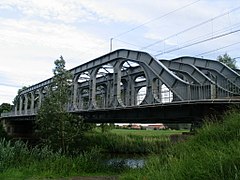Vierendeel bridge
 Vierendeel bridge at Grammene, Belgium | |
| Ancestor | Truss bridge |
|---|---|
| Related | None |
| Descendant | None |
| Carries | Pedestrians, pipelines, automobiles, trucks, light rail, heavy rail |
| Span range | Short to medium |
| Material | steel, reinforced concrete, prestressed concrete |
| Movable | Movable bridges of this type are very rare. Only one swing bridge of this type was known [1] (demolished Nov. 11-19th 2009) |
| Design effort | High (computer analysis required) |
| Falsework required | Depends upon length, materials, and degree of prefabrication |
A Vierendeel bridge is a bridge employing a Vierendeel truss. Such trusses do not have the usual triangular voids seen in a pin–joint truss bridge, rather employing rectangular openings and rigid connections in the elements, which (unlike a conventional truss) must also resist substantial bending forces. Owing to a lesser economy of materials and the difficulty of design before the advent of computers, this truss is rarely used in bridges outside Belgium. The form is more commonly employed in building structures where large shear walls or diagonal elements would interfere with the building's aesthetics or functionality.
The first such bridge was built in steel at Avelgem in Arthur Vierendeel's native Belgium in 1902, following development of the truss form and a method to calculate its strength in 1896 by Arthur Vierendeel. There are many more examples in Belgium, also constructed in concrete, mostly designed by Vierendeel's many students in a long career as professor in civil engineering.

